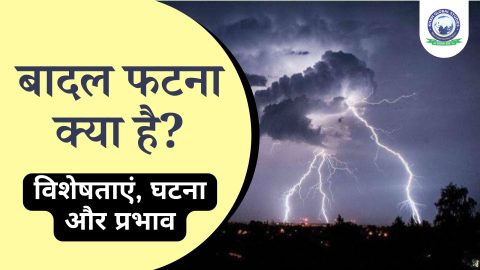Cloudburst refers to excessive rainfall occurring briefly, often accompanied by hail and thunderstorms. These intense downpours can cause flash floods and the rapid accumulation of very large quantities of water, making them particularly dangerous. Despite their potential for destruction, cloudbursts are rare events, usually triggered by the upwelling of moist air by specific geographical conditions, such as mountain ranges or hill lines. Generally, cloudbursts last only a few minutes, but significant damage can occur during that short time.
What is Cloudburst?
Cloudburst is a hydrological hazard in which heavy rainfall occurs over a small area within a short period. In India, cloudbursts occur mainly during the southwest monsoon season from June onwards. Due to their sudden and destructive nature, cloudburst prediction remains challenging. These events can cause severe erosion, flash floods, and significant damage.
How does Cloudburst Occur?
Cloudbursts are common in mountainous areas, where warm air currents rise from the ground, carrying the raindrops upward. This process prevents the rain from falling and leads to extensive condensation within the clouds. Large quantities of water accumulate at high altitudes, while warm air currents from below prevent the water from descending. Eventually, the upward currents weaken, causing the accumulated water to fall rapidly, resulting in torrential rain. Cloudbursts typically occur at altitudes between 1,000 and 2,500 metres above sea level.
Characteristics of Cloudburst
- A more than 100 mm per hour rainfall rate is considered a cloudburst.
- The Swedish Meteorological Service defines ‘Skyfall’ (Cloudburst) as 1 mm per minute for brief bursts or 50 mm per hour for prolonged rain.
- During a cloudburst, rainfall may exceed 20 mm in a very short time, leading to disastrous consequences including flooding.
Cloudburst Incidents in India
There have been several cloudburst incidents in India, which led to catastrophic flooding and loss of lives:
- Alaknanda Valley, July 1970: A cloudburst in the southern hilly region of the Alaknanda Valley caused severe flooding, releasing a huge amount of sediment in a single day.
- Malpa Village, August 1998: A landslide triggered by a cloudburst in Pithoragarh district of Uttarakhand killed 250 people, including 60 Kailash Mansarovar pilgrims.
- Badrinath Temple Area, July 2004: A cloudburst near the Badrinath temple in Chamoli district triggered a massive landslide, killing 17 people and injuring 28.
- Ukhimath, September 2013: A cloudburst in Rudraprayag district killed 39 people. A similar incident near Kedarnath and Rambada in June 2013 killed over 1,000 people.
- Pune, Maharashtra, September-October 2010: A series of cloudbursts caused heavy damage to vehicles and buildings, with many people injured or killed.
- Kashmir Valley, September 2014: Cloudbursts in the region killed over 200 people.
- Amarnath Cave, July 2022: A cloudburst on the way to the Amarnath cave shrine in Pahalgam claimed several lives.
Effects of Cloudburst
The aftermath of a cloudburst can be severe, including:
- Loss of lives of humans and animals.
- Damage to homes, buildings and infrastructure.
- Destruction of forests, crops and arable land.
- Flooding of rivers, causing further devastation.
Cloud Observatories in India
India is a monsoon-driven country, making it susceptible to cloud bursts, especially in the western Himalayas and on the west coast. To study cloud and rainfall dynamics, India has established several high-altitude cloud observatories equipped with advanced technology. These observatories aim to improve the understanding, forecasting, and monitoring of cloud burst events to reduce their impact.
The Himalayan Cloud Observatory in Tehri, Uttarakhand was established to forecast and study cloud burst events in the region. Although it is still in the testing phase, it is the second high-altitude observatory in India, developed by the Department of Science and Technology and IIT Kanpur.
Conclusion
Cloud bursts are sudden and devastating weather events that can cause catastrophic damage within minutes. Although predicting these events is challenging, understanding their characteristics and the conditions under which they occur can help reduce their impact. India, with its monsoon-driven climate, has witnessed many devastating cloud bursts. Continued research and development of advanced observatories is essential to improve our ability to forecast and respond to these events, which will ultimately help reduce loss of life and property.






Sir Mujhe, I A S karna hai